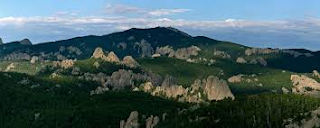Places: the Black Hills of South Dakota
This small but beautiful range of mountains in what is now South Dakota is famous for its gold of a distinctive color, and many landmarks of national interest. It is also sacred to the Lakota/Sioux people, the site of a minor gold rush, and the reason for the Great Sioux War of 1876-77.
The Black Hills are so-called after the Lakota name for them. It describes the dense forests on the slopes of these hills which make them appear black when seen from a distance. Black Elk Peak is the highest rise in the Black Hills, at over 7200 feet. Archaeology confirms the exists of Clovis cultures in the area. Prior to contact, the Hills were home to the Arikara, Cheyenne, Crow and Kiowa. In 1776, as the United States was busy fighting its war of independence from Great Britain, the Sioux migrated from Minnesota, took over the Black Hills from the Cheyenne and made these beautiful mountains part of their own culture. Pursuant to the terms of the Fort Laramie Treaty of 1868, the Black Hills were given to the Sioux as part of their reservation in perpetuity, with the U.S. promising to keep trespassers off the mountains.
Enter Col./Bvt. Maj. Gen. George Armstrong Custer, who led an expedition to the Black Hills in 1874 to verify the existence of gold. There was gold, an admixture of copper giving it a distinctive rose gold appearance. Miners poured into the Black Hills from 1875-78, running into Sioux War parties bent on keeping them out and demanding that the U.S. enforce the treaty. After the Sioux fled to Canada following the victory at Little Bighorn/Greasy Grass, the United States took over the Black Hills, something the Sioux have always contested. The government broke up the Great Sioux Reservation and formed five smaller reserves, carefully excluding the Black Hills area, where towns such as Deadwood were rapidly forming.
Today, the Black Hills is home to such attractions as Mount Rushmore, Wind Cave, Jewel Cave, Devils Tower and the Crazy Horse Memorial, among others. Thousands of tourists flock to South Dakota to see these and other points of interest. Some Lakota were/are not impressed by either Mount Rushmore or the Crazy Horse Memorial, in which whole mountains have been carved up into giant visages. They view it as a desecration of the land.
The Black Hills are so-called after the Lakota name for them. It describes the dense forests on the slopes of these hills which make them appear black when seen from a distance. Black Elk Peak is the highest rise in the Black Hills, at over 7200 feet. Archaeology confirms the exists of Clovis cultures in the area. Prior to contact, the Hills were home to the Arikara, Cheyenne, Crow and Kiowa. In 1776, as the United States was busy fighting its war of independence from Great Britain, the Sioux migrated from Minnesota, took over the Black Hills from the Cheyenne and made these beautiful mountains part of their own culture. Pursuant to the terms of the Fort Laramie Treaty of 1868, the Black Hills were given to the Sioux as part of their reservation in perpetuity, with the U.S. promising to keep trespassers off the mountains.
Enter Col./Bvt. Maj. Gen. George Armstrong Custer, who led an expedition to the Black Hills in 1874 to verify the existence of gold. There was gold, an admixture of copper giving it a distinctive rose gold appearance. Miners poured into the Black Hills from 1875-78, running into Sioux War parties bent on keeping them out and demanding that the U.S. enforce the treaty. After the Sioux fled to Canada following the victory at Little Bighorn/Greasy Grass, the United States took over the Black Hills, something the Sioux have always contested. The government broke up the Great Sioux Reservation and formed five smaller reserves, carefully excluding the Black Hills area, where towns such as Deadwood were rapidly forming.
Today, the Black Hills is home to such attractions as Mount Rushmore, Wind Cave, Jewel Cave, Devils Tower and the Crazy Horse Memorial, among others. Thousands of tourists flock to South Dakota to see these and other points of interest. Some Lakota were/are not impressed by either Mount Rushmore or the Crazy Horse Memorial, in which whole mountains have been carved up into giant visages. They view it as a desecration of the land.




Comments
Post a Comment